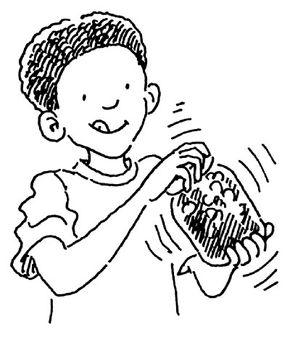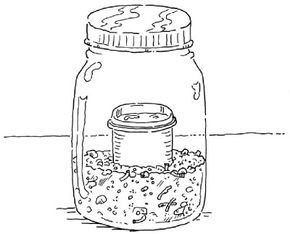 “Dirt Discovery is a science project that teaches kids to examine layers of soil.©2007 Publications International, Ltd.
“Dirt Discovery is a science project that teaches kids to examine layers of soil.©2007 Publications International, Ltd.
Science projects for kids: soil experiments are great educational tools that keep children engaged and teach lasting lessons. Soil experiments teach kids about the environment through active participation.
These soil experiments for kids are inexpensive and easy science projects, perfect for a classroom lesson or summertime fun. Inspire kids to learn more about the earth with these innovative soil experiments.
On the following pages, you’ll learn about science projects for kids: soil experiments that make ideal science projects for kids.
Dirt Discovery
Teach kids how to examine different layers of soil with this science project. Dirt Discovery is a soil experiment that teaches kids how to separate layers of earth.
Who Needs Dirt?
This easy science project for kids is both fun and productive. Find out how to grow a sweet potato plant without water in this soil experiment.
Lowdown on Dirt
Get directions for a science experiment that teaches kids how to determine soil quality. Find out about the Lowdown on Dirt, an easy soil experiment.
Look Mom, No Dirt!
Just how many plants can you grow without water? Find out when you perform Look Mom, No Dirt!
Down and Dirty
Learn how to find creatures that live in dirt using lime-water during this soil experiment. Read about this science project for kids.
Dirt Discovery encourages kids to shake it up and learn about soil composition. Make a Dirt Discovery on the next page of science projects for kids: soil experiments.
Looking for more science projects to do with your kids? Try:
- Science Projects for Kids: The Moon
- Science Projects for Kids: Classifying Plants
- Science Projects for Kids: Light and Heat
Contents
- Dirt Discovery
- Who Needs Dirt?
- Lowdown on Dirt
- Look Mom, No Dirt!
- Down and Dirty
Dirt Discovery
 “Dirt Discovery is a science project that teaches kids to examine layers of soil.©2007 Publications International, Ltd.
“Dirt Discovery is a science project that teaches kids to examine layers of soil.©2007 Publications International, Ltd.
Dirt Discovery is a science project that teaches kids about soil composition. There’s more to dirt than you think! Find out what it’s made of.
What You’ll Need:
- Waterproof table covering
- Jar with lid
- Spoon
- Dirt
- Pitcher of water
- Paper towels
- Magnifying glass
How to Conduct the Dirt DiscoveryScienceProject:Step 1: Cover your work surface. Fill a jar halfway with dirt. Add water nearly to the top of the jar. Put the lid on, and tighten it securely.
Step 2: Shake the jar vigorously for a half a minute, and then set it down. Let the jar stand until the dirt and water settle. The soil will settle into layers.
Step 3: Observe the layers in the jar, and see what you can tell about them. How many layers are there? Which layer is made of the biggest particles? Which is made of the smallest? Can you guess why?
Step 4: To further examine the different layers and what they are made of, you can sort out the soil materials and examine them. Use a spoon to skim off the objects floating in the water. Place them on a paper towel.
Step 5: Then carefully pour off the water on the top and scoop out the grains of the next level onto another paper towel. Do the same if there is another level.
Step 6: After each layer has been placed onto towels, they can be examined with the magnifying glass. What else can you tell about the different layers after further examination?
Step 7: You can also do this experiment with dirt you have collected from different areas and compare your findings. Draw pictures of each jar full of soil after you have shaken it and the dirt has settled to make picture comparisons.
Who Needs Dirt? Your kids might be asking this question after you teach them how to grow a sweet potato plant in nothing but water. Read about this science project on the next page of science projects for kids: soil experiments.
Looking for more science projects to do with your kids? Try:
- Science Projects for Kids: The Moon
- Science Projects for Kids: Classifying Plants
- Science Projects for Kids: Light and Heat
Who Needs Dirt?
Who Needs Dirt? In this science project, you can teach kids to grow a sweet potato plant without soil — all you’ll use are toothpicks and water.
How to find out Who Needs Dirt?
What You’ll Need:
- Toothpicks
- Sweet potato
- Glass
- Water
Step 1: Insert three toothpicks around a sweet potato near the large end so they stick out to the sides in different directions.
Step 2: Fill a glass most of the way with water. Put the sweet potato into the glass small-end first, and rest the toothpicks on the rim so they hold up the sweet potato. There should be enough water in the glass so that about 3/4 of the sweet potato is covered.
Step 3: Put the jar in a sunny spot for several days. Add water as needed. Soon you will have a beautiful vine growing from the top of the potato.
Lowdown on Dirt is a science project that teaches kids to compare different kinds of soil and determine which is better. Read about Lowdown on Dirt on the next page of science projects for kids: soil experiments.
Looking for more science projects to do with your kids? Try:
- Science Projects for Kids: The Moon
- Science Projects for Kids: Classifying Plants
- Science Projects for Kids: Light and Heat
What Happened?
Usually you put a plant into soil to make it grow, but you can grow some plants without soil. When the sweet potato plant was growing with its roots in the water and its leaves in the sun, it produced food through photosynthesis and the stored carbohydrates in the potato. This stored food in the sweet potato provided the energy needed to grow a new plant.
Lowdown on Dirt
The Lowdown on Dirt is a science project that teaches kids about soil quality. When it comes to supporting plant life, not all dirt is equal.
What You’ll Need:
- Garden soil
- Trowel
- Small flowerpots with saucers
- Water
- Bean seeds
- Tall stakes
- Pencil or pen
- Ruler
- Paper (graph paper optional)
- Tape
How to get the Lowdown on Dirt:Step 1: Look in your yard for areas where plants grow poorly. Is the soil trampled and hard? Is the soil soft and loose where plants grow well? Look for sandy or heavy, clay-like soil.
Step 2: Gather samples of different soils and fill a flowerpot with each kind. Label your flowerpots: "Hard, baked soil near the sidewalk," "Loose, fluffy soil from the flower bed," etc.
Step 3: Water the pots, then plant two or three bean seeds in each. Put a stake in each pot for the beans to climb. Keep the pots moist (but not soggy) while the beans sprout.
Step 4: Notice which beans sprout first. Measure the height of the plants every few days until the beans flower. Keep a chart. Which soil was the best?
Look Mom, No Dirt! is a science project that teaches kids to grow plants without soil. Find out how to learn about plant growth on the next page of science projects for kids: soil experiments.
Looking for more science projects to do with your kids? Try:
- Science Projects for Kids: The Moon
- Science Projects for Kids: Classifying Plants
- Science Projects for Kids: Light and Heat
Look Mom, No Dirt!
Look Mom, No Dirt! is a science project that teaches kids just how many plants can be grown without dirt. Believe it or not, while most plants in nature grow in soil, it’s possible to grow plants without it.
What You’ll Need:
- Wire mesh
- Aquarium
- Plant food
- Water
- Sphagnum moss
- Bean or corn seeds
How to conduct the Look Mom, No Dirt! science project:
Step 1: Put a piece of wire mesh (like a piece of old screen) in the bottom of an empty aquarium. Bend the ends of the mesh so that it makes a shelf that is several inches above the bottom of the aquarium.
Step 2: Mix plant food into some water, and pour the water into the aquarium. The water level should be just below the mesh.
Step 3: Put some sphagnum moss on top of the mesh. Then sprinkle some bean or corn seeds onto the moss, and water them well. Keep the seeds watered. Even though there’s no soil, the seeds will sprout and send roots down through the mesh into the water that contains plant food.
Down and Dirty is a science project that teaches kids about all the creatures that live in soil. Read about Down and Dirty on the next page of science projects for kids: soil experiments.
Looking for more science projects to do with your kids? Try:
- Science Projects for Kids: The Moon
- Science Projects for Kids: Classifying Plants
- Science Projects for Kids: Light and Heat
Down and Dirty
 “Down and Dirty is a science project that uses limewater to distinguish soil.©2007 Publications International, Ltd.
“Down and Dirty is a science project that uses limewater to distinguish soil.©2007 Publications International, Ltd.
Down and Dirty is a science project that teaches kids about all the creatures that live in the dirt. Soil contains microscopic animals that breathe.
What You’ll Need:
- Garden soil
- Jar with a lid
- Limewater (available at a drugstore)
- Small container
How to conduct the Down and Dirty experiment:Step 1: Drop a large handful of garden soil into the bottom of a big, empty jar. Pour some lime-water into a small container. Note what the lime-water looks like.
Step 2: Set the container of lime-water, uncovered, inside the large jar so it rests on top of the soil. Tightly screw on the lid of the large jar, and leave it undisturbed.
Step 3: In 2 or 3 days, look at the lime-water to see if it has changed in any way.
Looking for more science projects to do with your kids? Try:
- Science Projects for Kids: The Moon
- Science Projects for Kids: Classifying Plants
- Science Projects for Kids: Light and Heat
ABOUT THE PROJECT DESIGNERS:
Lowdown on Dirt by Maria Birmingham, Karen E. Bledsoe, and Kelly Milner Halls
What Happened?
The soil contains many microscopic animals. These animals take in oxygen and release carbon dioxide as a waste product, just as you do when you breathe. The lime-water turned a milky color because the carbon dioxide produced by the organisms in the soil combined with the lime-water to produce chalk. Your garden soil may contain bacteria, protozoans, and threadlike worms called nematodes.







































